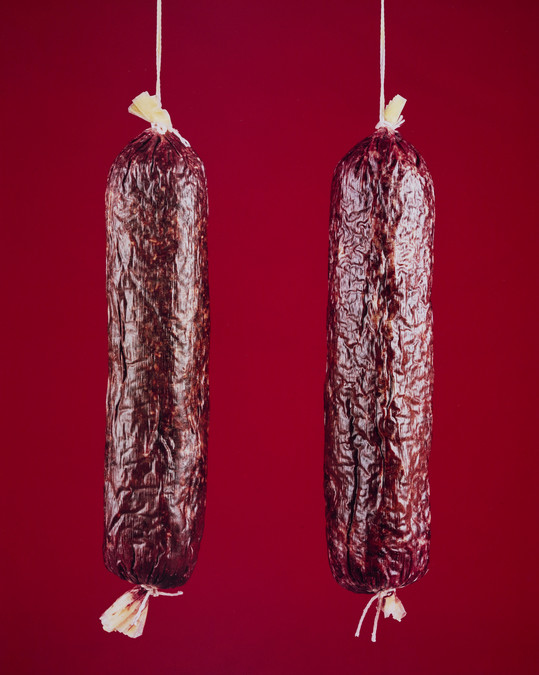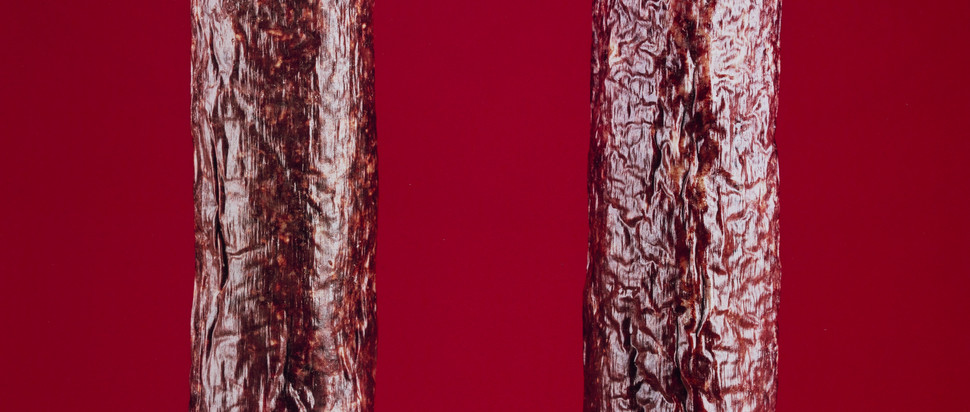National Galleries Scotland: Beagles & Ramsay
Beagles & Ramsay's Sanguis Gratia Artis (Black Pudding Self Portrait) is on display for the first time since being added to Scotland's national collection. We talk to the artists about making work with their own blood

Your work is on display in the National Galleries Scotland: Portrait as part of the exhibition Celebrating 40 Years of Scotland’s Photography Collection. What will audiences be able to see when they explore the galleries?
The title is Sanguis Gratia Artis (Black Pudding Self Portrait), a Latin phrase that translates as blood for the sake of art. First made in 2004, and it was acquired for the National Galleries collection in 2018.
In the exhibition you can see a pair of puddings hanging in a glass fronted fridge, that were made using our blood. They will be slowly rotting over the next few months. There are also three photographs, the recipe and a video that shows the process of extracting our blood, preparing and cooking the puddings. The residue of our opening night performance is also there – a grease-stained white tablecloth, and lingering smell of fried blood and fat.
The video shows a performance – what happened in that performance? Where was it?
This was the original performance at PS1 MoMA in New York in 2004. There were a few challenges with this one. Firstly, we had to smuggle the puddings into the US during the period when British blood was banned due to Mad Cow disease, and then the cooking performance was almost cancelled by a museum manager who suddenly realised what we were about to fry up.
You use your blood combined to make the black pudding – why did you choose that particular meat product? Does it have a cultural or personal significance?
The black puddings followed an earlier work Burgerheaven, a fast-food franchise that featured burgers flavoured to taste like the flesh of dead celebrities, such as John Lennon, Kurt Cobain and Princess Diana. It was the Good Die Young range. The broader backdrop to Sanguis’ germination was the lingering aftertaste of Cool Britannia and the uncritical celebration of New Labour’s desire to make us all middle class. This was also a ripe transitional moment for black pudding. Although it was rebranded next to the scallop as signifier of New Labour credit-fueled chic consumerism, there was still something indigestible about the pudding. It's a meat product for those who can’t afford actual meat. It's ersatz meat. Mock meat.
So, while dull readings of this work fixated on the ‘sensational art’ shock, we were, in part, speculating about an imminent moment of social shock, where making sausages from your own blood, might be your only survival option. It was in part a Swiftian expression of the folly of that moment, and also the pricking of a commodified form of shock, that tended to dominate the artworld in the 2000s.
Where did the recipe come from?
Black pudding is an archetypal peasant food – there are multiple recipes across diverse cultures. There’s no origin, no source of purity. The unifying ingredient is the absence of actual flesh meat and its substitution with waste blood.

Sanguis Gratia Artis (Black Pudding Self-Portrait), 2004, by John Beagles and Graham Ramsay. National Galleries of Scotland. Presented through Art Fund New Collecting Awards
Why did you choose this medium and this form to create a self-portrait?
Like most artists of our generation we benefitted from the impact of artists and teachers whose work was informed by the feminist assertion that the personal is political. Consequently, any portraits we made were never for us just narcissistic images of the self, but equally carriers of broader social content. In Sanguis, we saw potential to create a self-portrait that was related closely to the body, but was anti-heroic, comic and somewhat daft.
Are there other self-portraits that you see the piece in conversation with?
‘Self’ portrait is a questionable term for us because we’re a collaborative duo who’ve always created fictionalised, surrogate versions of ourselves. We’re interested in portrayals of self by Cindy Sherman, Mike Kelley & Paul McCarthy, along with the carnivalesque grotesqueries of Breughel, Ensor or Mika Rottenberg.
The performance first took place over 20 years ago – how do you look on it now, is it now a past self-portrait?
We always conceived of Sanguis as a social portrait, not a psychological investigation of the private self, so consequently it’s less hobbled by changing times and some of the baggage that comes with traditional ideas about the self-portrait. So, while our hair is thinner and greyer, the claggy flavour of the work has matured and deepened with age. As mentioned before, the social forces the work was trying to ventriloquise are as prevalent and potent as ever.
What happened to the black puddings?
Each time we exhibit this artwork we have more blood extracted to make a fresh batch of puddings, which are then cooked and disposed of. ‘Disposal’ can mean different things depending on the situation... for example, there were occasions in the past when viewers ate them after we did the cooking performance. Another time we were instructed by a city authority to incinerate them as if they were medical waste.
Can we have the recipe?
The recipe is available on the wall of the gallery. Feel free to make your own.
Beagles & Ramsay's Sanguis Gratia Artis (Black Pudding Self Portrait) is on display as part of Celebrating 40 Years of Scotland’s Photography Collection, National Galleries Scotland: Portrait, until 16 Mar, free
To find out more visit www.nationalgalleries.org
